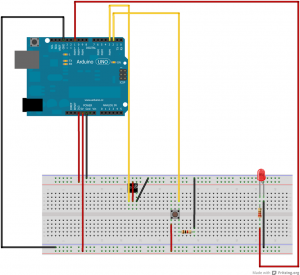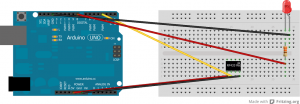Fév 102013
I wanted to find a way to call my kids, with me sitting on ground floor and them, sitting on the top floor of the house.
2 arduino, one acting as transmitter, one acting as receiver and here we go : they would not ignore me anymore 🙂
Lets start the transmitter (schema and code) : it has a push button to send the signal and a led to indicate it is transmitting.
#includeconst int led_pin = 11; //const int transmit_pin = 4; //const int transmit_en_pin = 3; const int transmit_pin = 3; //const int transmit_en_pin = 3; const int buttonPin=2; void setup() { pinMode(buttonPin, INPUT); // sets the digital pin as output pinMode(led_pin, OUTPUT); // sets the digital pin as output delay(1000); Serial.begin(9600); // Debugging only Serial.println("setup"); // Initialise the IO and ISR vw_set_tx_pin(transmit_pin); //vw_set_rx_pin(receive_pin); //vw_set_ptt_pin(transmit_en_pin); //vw_set_ptt_inverted(true); // Required for DR3100 vw_set_ptt_inverted(false); vw_setup(2400); // Bits per sec } byte count = 1; void loop() { int reading = digitalRead(buttonPin); if(reading==HIGH) { // digitalWrite(led_pin, HIGH); // Flash a light to show transmitting char msg[7] = {'h','e','l','l','o',' ','#'}; //msg[5]=count; vw_send((uint8_t *)msg, strlen(msg)+1); vw_wait_tx(); // Wait until the whole message is gone Serial.println(count); count = count + 1; delay(500); digitalWrite(led_pin, LOW); } }
Next comes the receiver : it has a buzzer playing a small melody and a led blinking to indicate it is receiving.
#include#include const int led_pin = 8; const int receive_pin = 3; //2 const int buzzer=11; // tableau de mémorisation des notes de la mélodie int melody[] = { NOTE_C4, NOTE_G3,NOTE_G3, NOTE_A3, NOTE_G3,0, NOTE_B3, NOTE_C4}; // tableau de mémorisation de la durée des notes : 4 = noire, 8 = croche, etc.: int noteDurations[] = {4, 8, 8, 4,4,4,4,4 }; void play(){ // boucle pour parcourir les notes de la mélodie for (int thisNote = 0; thisNote < 8; thisNote++) { // thisNote de 0 à 7 // pour calculer la durée de la note, on divise 1 seconde par le type de la note //ainsi noire = 1000 / 4 sec, croche = 1000/8 sec, etc... int noteDuration = 1000/noteDurations[thisNote]; // joue la note sur la broche x pendant la durée voulue tone(buzzer, melody[thisNote],noteDuration); // pour distinguer les notes, laisser une pause entre elles // la durée de la note + 30% fonctionne bien : int pauseBetweenNotes = noteDuration * 1.30; delay(pauseBetweenNotes); // delai entre les notes // stoppe la production de son sur la broche 8 : noTone(buzzer); } } void setup() { pinMode(led_pin, OUTPUT); // sets the digital pin as output pinMode(buzzer, OUTPUT); // sets the digital pin as output delay(1000); Serial.begin(9600); // Debugging only Serial.println("setup"); // Initialise the IO and ISR //vw_set_tx_pin(transmit_pin); vw_set_rx_pin(receive_pin); //vw_set_ptt_pin(transmit_en_pin); //vw_set_ptt_inverted(true); // Required for DR3100 vw_set_ptt_inverted(false); vw_setup(2400); // Bits per sec vw_rx_start(); // Start the receiver PLL running } void loop() { uint8_t buf[VW_MAX_MESSAGE_LEN]; uint8_t buflen = VW_MAX_MESSAGE_LEN; if (vw_get_message(buf, &buflen)) // Non-blocking { int i; // Message with a good checksum received, print it. Serial.print("Got: "); for (i = 0; i < buflen; i++) { Serial.print(buf[i], HEX); Serial.print(' '); } Serial.print(' '); for (i = 0; i < buflen; i++) { Serial.print(char(buf[i])); Serial.print(' '); } Serial.println(); digitalWrite(led_pin, HIGH);delay(1500);digitalWrite(led_pin, LOW);delay(1500); digitalWrite(led_pin, HIGH);delay(1500);digitalWrite(led_pin, LOW);delay(1500); play(); } }
Voila !


[…] a previous article, we have seen how to use RF433 chips with […]
Le prototype,ok. A quand la finalisation dans un boitier compact et autonome ? 😉 (ceci est un messagebsubliminal – ou pas)
[…] a previous article, we have seen how to use RF433 chips with […]